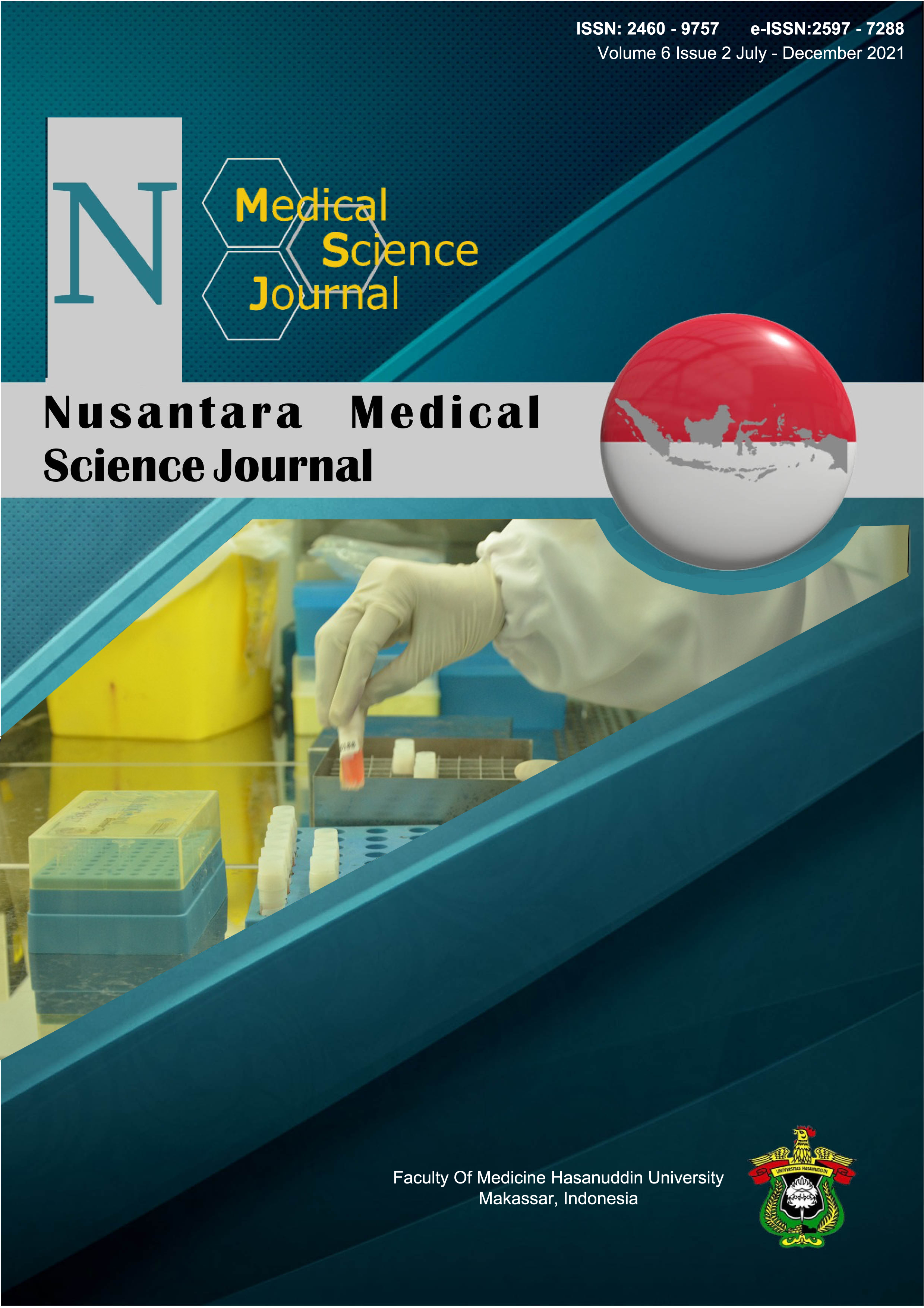IL-1β Expression of Patients with Chronic Rhinosinusitis is negatively correlated with Lund-Mackay score
DOI:
https://doi.org/10.20956/nmsj.v6i2.18765Abstract
Introduction: IL-1β is one of the proinflammatory cytokines which is commonly found in various diseases, including Chronic Rhinosinusitis (CRS). It has been widely targeted as a therapeutic approach for inflammatory diseases. However, study of IL-1β expression and its correlation with CT-Scan grading scores in CRS is still scarce. Objective: To investigate IL-1β expression based on immunohistochemical examination and analyse its correlation with Lund-Mackay score in CRS with and without polyps. Method: This analytic observational study was done on 50 patients: 25 subjects in the CRS with Nasal Polyps (CRSwNP) group and 25 subjects in the CRS without Nasal Polyps (CRSsNP) group. The uncinate process was taken for immunohistochemical examination of IL-1β. Lund-Mackay score was calculated based on CT-Scan of the paranasal sinus. Result: IL-1β expression in CRSsNP (mean=36.38) was significantly higher than that in the CRSwNP (mean=14.62) with p<0.001. Lund-Mackay score in CRSwNP was higher (mean=35.22) compared to CRSnNP group (mean=15.78) with p<0.001. There was a moderate negative correlation (-0.403) between IL-1β expression and Lund-Mackay score (p<0.05). Conclusion: There was a moderate negative correlation between IL-1β expression and Lund-Mackay score. The IL-1β and the Lund-Mackay score in CRSwNP were lower and higher, respectively, than in CRSsNP
References
Fokkens WJ, Lund VJ, Hopkins C, Hellings PW, Kern R, Reitsma S, et al. European Position Paper on Rhinosinusitis and Nasal Polyps 2020. Rhinology. 2020;58(Suppl S29):1-464.
Patel ZM, Hwang PH. Nonpolypsoid Rhinosinusitis: Pathogenesis, Diagnosis, Staging, and Treatment. In: Johnson J, Rosen C, editors. Bailey's Head and Neck Surgery: Otolaryngology. Fifth ed. Philadelphia: Wolters Kluwer Health; 2014. p. 535-49.
Mustafa M, Patawari P, Iftikhar H, Shimmi S, Hussain S, Sien M. Acute and chronic rhinosinusitis, pathophysiology and treatment. Int J Pharm Sci Invent. 2015;4(2):30-6.
Endam LM, Cormier C, Bossé Y, Filali-Mouhim A, Desrosiers M. Association of IL1A, IL1B, and TNF gene polymorphisms with chronic rhinosinusitis with and without nasal polyposis: a replication study. Archives of Otolaryngology–Head & Neck Surgery. 2010;136(2):187-92.
Lopez-Castejon G, Brough D. Understanding the mechanism of IL-1β secretion. Cytokine Growth Factor Rev. 2011;22(4):189-95.
Dinarello CA. Interleukin-1 in the pathogenesis and treatment of inflammatory diseases. Blood, The Journal of the American Society of Hematology. 2011;117(14):3720-32.
Triola S. The Effect of Nasal Wash with 0.9% NaCl on the Expression of IL-1Beta and TNF-Alpha Genes in the Nasal Mucosa of Chronic Rhinosinusitis Patients at dr M Djamil Hospital, Padang. Health and Medical Journal. 2019;1(2):17-27.
Min HJ, Kim SJ, Kim TH, Chung HJ, Yoon JH, Kim CH. Level of secreted HMGB 1 correlates with severity of inflammation in chronic rhinosinusitis. The Laryngoscope. 2015;125(7):E225-E30.
Lal D, Rounds AB, Divekar R, editors. Gender‐specific differences in chronic rhinosinusitis patients electing endoscopic sinus surgery. International forum of allergy & rhinology; 2016: Wiley Online Library.
Younis RT, Ahmed J. Predicting revision sinus surgery in allergic fungal and eosinophilic mucin chronic rhinosinusitis. The Laryngoscope. 2017;127(1):59-63.
Savastano V, Bertin S, Vittori T, Tripodi C, Magliulo G. Evaluation of chronic rhinosinusitis management using the SNOT-22 in adult cystic fibrosis patients. Eur Rev Med Pharmacol Sci. 2014;18(14):1985-9.
Lal D, Hopkins C, Divekar RD, editors. SNOT‐22–based clusters in chronic rhinosinusitis without nasal polyposis exhibit distinct endotypic and prognostic differences. International forum of allergy & rhinology; 2018: Wiley Online Library.
Liu T, Zhou YT, Wang LQ, Li LY, Bao Q, Tian S, et al. NOD-like receptor family, pyrin domain containing 3 (NLRP3) contributes to inflammation, pyroptosis, and mucin production in human airway epithelium on rhinovirus infection. J Allergy Clin Immunol. 2019;144(3):777-87. e9.
Plewka D, Grzanka A, Drzewiecka E, Plewka A, Misiołek M, Lisowska G, et al. Differential expression of tumor necrosis factor α, interleukin 1β, nuclear factor κB in nasal mucosa among chronic rhinosinusitis patients with and without polyps. Advances in Dermatology and Allergology/Postȩpy Dermatologii i Alergologii. 2017;34(3):199.
Scheckenbach K, Wagenmann M. Cytokine patterns and endotypes in acute and chronic rhinosinusitis. Curr Allergy Asthma Rep. 2016;16(1):1-8.
Deng J, Chen F, Lai Y, Luo Q, Xu R, Ou C, et al., editors. Lack of additional effects of long‐term, low‐dose clarithromycin combined treatment compared with topical steroids alone for chronic rhinosinusitis in China: a randomized, controlled trial. International forum of allergy & rhinology; 2018: Wiley Online Library.
Saber A, Hussain R, Nakka SS, Hugosson S. Effect of Staphylococcus aureus on the NLRP3 inflammasome, caspase-1 and IL-1β expression in the nasal epithelial cells in chronic rhinosinusitis. Archives of Otolaryngology and Rhinology. 2019;5(1):1-7.
Langereis J, Oudijk ED, Schweizer R, Lammers JJ, Koenderman L, Ulfman L. Steroids induce a disequilibrium of secreted interleukin-1 receptor antagonist and interleukin-1β synthesis by human neutrophils. Eur Respir J. 2011;37(2):406-15
Downloads
Published
How to Cite
Issue
Section
License
Copyright (c) 2021 Nusantara Medical Science Journal

This work is licensed under a Creative Commons Attribution 4.0 International License.









